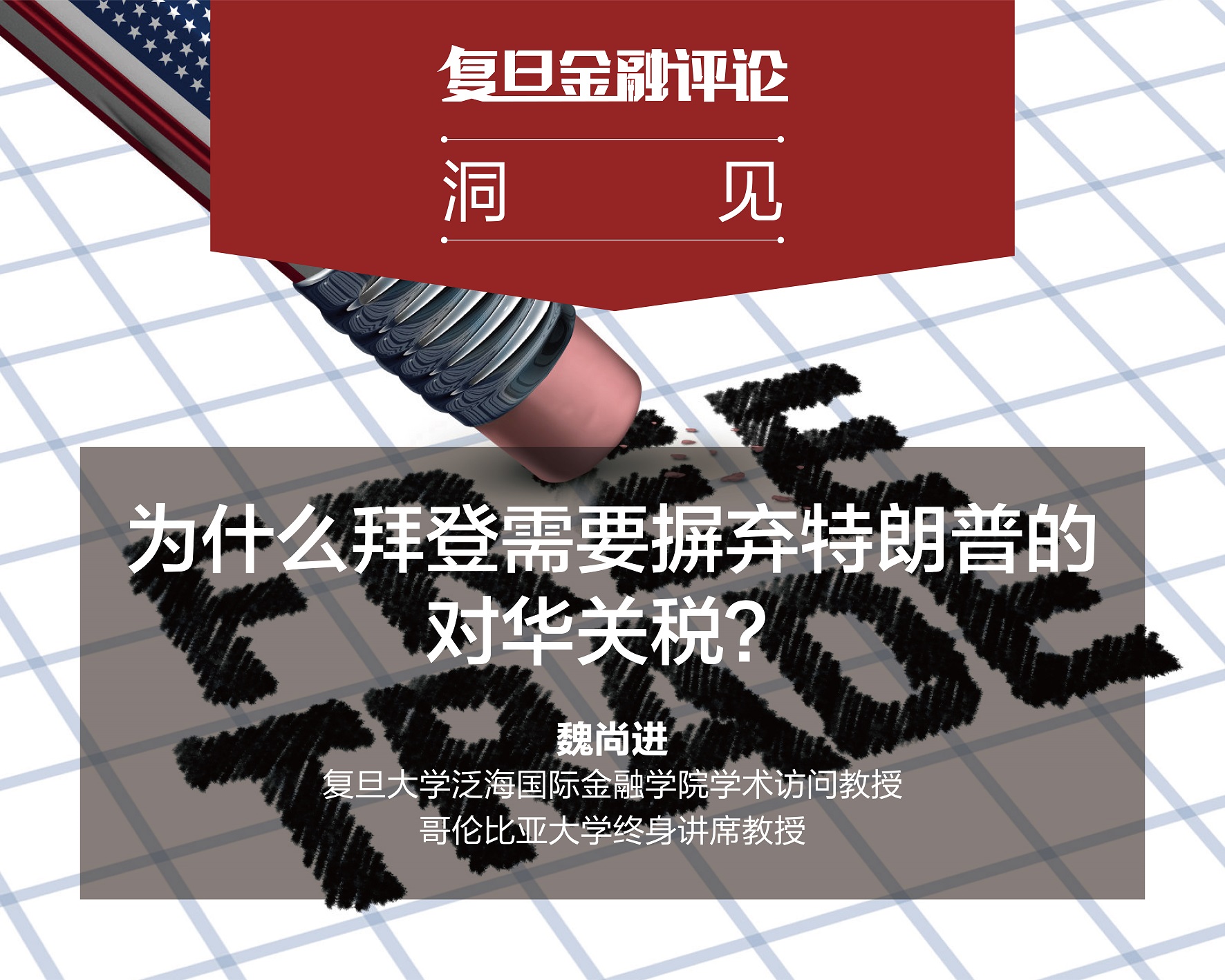为什么拜登需要摒弃特朗普的对华关税?

导语
维持特朗普政府的关税不利于拜登实现美国包容性经济复苏的目标。

Over the course of his presidency, Donald Trump raised US tariffs on imports from China several times, from an average of about 3% when he took office in January 2017 to over 20% by the end of 2019. [1]As a result, the current average US tariff on Chinese goods is essentially at the same level that the United States imposed on the rest of the world in the early 1930s under the Smoot-Hawley Act, a protectionist measure that many economists blame for the severity of the Great Depression. Now that President Joe Biden is reversing many of Trump’s policies, including import tariffs on European goods, he has to decide whether to rescind his predecessor’s China tariffs, too.
唐纳德·特朗普(Donald Trump)在总统任期内多次提高美国自华进口商品的关税,从2017年1月就任时的平均约3%提高到2019年底的20%以上。因此,美国目前对中国商品征收的平均关税,基本上相当于20世纪30年代初美国根据《斯穆特-霍利关税法》(Smoot-Hawley Act)对全球其他国家征收的关税税率。大多数经济学家认为,《斯穆特-霍利关税法》使当时的经济大萧条雪上加霜。美国总统乔·拜登(Joe Biden)正在逆转特朗普的许多政策,包括撤销对欧洲商品征收的进口关税,也需要决定是否取消上届政府对中国征收的关税。
President Biden will not do so for Chinese workers or firms, not least because he needs to protect himself from accusations of being too soft toward the United States’ main global rival. But he has three stronger reasons to ditch the tariffs: They have hurt American workers and firms, failed to reduce the overall US trade deficit, and arguably further weakened respect for global economic rules.
拜登总统不会为了中国工人或企业这么做,一个重要的原因是他需要保护自己不在其国内被谴责为对美国的主要竞争对手过于软弱。但是,拜登取消关税其实有三个更充分的理由:关税损害了美国工人和企业的利益,也未能减少美国的总体贸易赤字,并且削弱了各国对全球经济规则的尊重。
Of all evidence-based studies by US-based economists, none has found that Trump’s trade war benefited American households or businesses. Mary Amiti of the Federal Reserve Bank of New York, Stephen Redding of Princeton University, and David Weinstein of Columbia University have studied Trump’s six tariff hikes on Chinese goods during 2018, which increased the share of US imports facing a duty of 10% or more from 3.5% to 10.6%. Contrary to what Trump and his senior trade officials claimed, the higher tariffs fed through almost entirely into higher prices paid by American consumers.
在所有美国经济学家关于贸易战的实证研究中,没有任何一项研究发现特朗普的贸易战让美国家庭或企业受到益处。纽约联邦储备银行的玛丽·阿米蒂(Mary Amiti)博士、普林斯顿大学的斯蒂芬·雷丁(Stephen Redding)教授和哥伦比亚大学的大卫·韦恩斯坦(David Weinstein)教授对特朗普2018年6次对中国商品加征关税进行了仔细研究,发现这些措施不仅将美国面临10%以上关税的进口商品比例从3.5%提高到了10.6%, 而且新增的关税几乎完全一一对应地转化为美国消费者被迫支付的更高价格。这样的结果与特朗普及其高级贸易官员当时声称的情况完全背道而驰。
Meanwhile, US imports of similar goods from other countries also became more expensive in response to the tariff hikes. So, although the federal government collected extra tariff revenue, this was merely a transfer from American households to the US Treasury. Other studies have reached similar conclusions.
与此同时,美国从其他国家进口的类似商品也因对华关税上调而变得更加昂贵。尽管联邦政府收了额外的关税,但这都是变相由美国家庭向美国财政部做出“转移支付”。另外两篇由一流经济学家做出的研究也得出了类似的结论。
Because Chinese consumer products in the US are disproportionately purchased by middle- and low-income households, Trump’s tariffs were a de facto regressive tax. They thus skewed further America’s already highly unequal income distribution.
由于中国生产的消费品卖给美国中低收入家庭的比例较高,特朗普政府的关税实际上是一种累退税。因此,对华额外关税进一步扭曲了美国已经高度不平等的收入分配。
China’s retaliatory tariffs on American products have led to additional economic losses in the US – evident in reduced sales of durable goods such as automobiles. As different regions specialize in different industries, some are more affected by Chinese retaliatory tariffs than others. Michael Waugh of New York University has found that automobile sales fell significantly (by about 15%) in US regions more exposed to Chinese trade retaliation, suggesting a decrease in household income. Such regions also suffered a decline in employment.
中国对美国产品征收的报复性关税,也给美国带来了进一步的经济损失。这可以从美国国内汽车等耐用品销量显著下降的区域特点上看出。不同地区因为当地产业结构不同,受中国报复性关税的影响也不一。纽约大学的迈克尔•沃(Michael Waugh)研究表明,在受中国贸易报复影响更大的美国地区,汽车销量大幅下降(约15%),这表明这些地区的许多家庭收入明显下降。另外,对地区就业数据的分析表明这些地区的就业率也明显恶化。
Some US sectors that compete with Chinese imports received some protection. But this benefit was more than offset by job destruction in sectors that use Chinese inputs – including services as well as manufacturing – and by job losses resulting from lower US exports to China.
虽然某些美国行业与中国进口产品竞争因美国对华关税得到保护,但这些效应完全被贸易战其他方面的坏处所抵消。多数使用中国产品作为中间投入品的行业(包括服务业和制造业)工作岗位受到严重负面影响,而且美国对华出口下降也导致的许多就业岗位减少。
Moreover, the US trade balance sees no improvement from Trump’s tariffs. The bilateral deficit with China in 2019 was essentially the same in dollar terms(about $345 billion) as it was in 2016, the last full year of President Barack Obama’s administration. This reflected equal reductions of about $10 billion each in US exports to and imports from China.
特朗普政府的关税政策也没有改善美国贸易失衡的状况。2019年美国对华双边贸易逆差(约3 450亿美元)以美元计与2016年,也就是和奥巴马政府执政最后一年的情况基本相同。这一数据背后反映的是美国对华出口和进口均分别减少约100亿美元。
The pattern continued in 2020. Although the bilateral deficit decreased to $311 billion, this was partly because the pandemic-induced recession reduced overall US imports. And while US exports to China rose from $107 billion in 2019 to $125 billion in 2020 under the two countries’ “phase one” trade agreement, this figure is similar to the level in 2018, but lower than the 2017 total of $130 billion.
在2020年,尽管美国双边贸易逆差减少到3110亿美元,但部分原因是新冠肺炎疫情导致的美国经济衰退减少了其进口总量。根据中美第一阶段贸易协议,美国对中国的出口从2019年的1070亿美元增加到2020年的1250美元,这一数字与2018年的水平相当,但远远低于2017年的1300亿美元。
Higher US tariffs on Chinese goods merely shifted imports of some products to other countries. Whereas the bilateral trade balance with China is not very important for Americans’ well-being, the overall US trade deficit, which rose to a 12-year high in 2020, reflects a shortage of US national savings relative to national investment.
美国对中国商品征收更高的关税,只是将对部分产品的进口转移到了其他国家。经济学逻辑告诉我们美国对任何一国的双边贸易逆差没有其对全球的总贸易逆差重要,而美国的总体贸易逆差(在2020年升至12年来的最高水平)反映出的是美国国民储蓄相对于国民投资明显不足。
While China could do more to reduce its own trade barriers, these are not the reason for its trade surplus. In fact, my research with Jiandong Ju and Kang Shi suggests that China’s import liberalization in the early 2000s has contributed to a rise in its overall trade surplus.
虽然中国还有进一步开放的空间,但这些都不是其贸易顺差的原因。事实上,我与鞠建东和施康两位学者的合作研究表明,21世纪初中国的开放、包括降低进口壁垒,实际上是其总体贸易顺差的上升的重要原因之一[2]。
Repealing Trump’s tariffs on Chinese goods is essential to reviving confidence in the global trading system. In September 2020, a WTO dispute panel ruled the US tariffs illegal under the organization’s rules. The US has the right to appeal the decision, but the Trump administration disabled the WTO’s Appellate Body by refusing to confirm new judges when the previous incumbents’ terms expired, rendering the body inquorate.
撤销特朗普对中国商品征收的关税,对于重建各国对全球贸易体系的信心也至关重要。2020年9月,世贸组织争端小组根据其规则裁定美国对华额外征收的关税是非法的。美国虽然有权对这一裁决提起上诉,但特朗普政府在前任法官任期届满时拒绝确认新法官,导致WTO上诉机构难以运行,致使世贸组织因不足法定人数陷入停摆。
Ignoring the WTO ruling could weaken the credibility of the Biden administration’s professed interest in strengthening the rules-based global system. The longer the Trump tariffs remain, the longer America’s middle- and low-income households will have to bear the burden. Like economic damages from the Smoot-Hawley tariffs in the 1930s, a continuation of the Trump tariffs will work seriously against Biden’s objective of an inclusive economic recovery.
无视世贸组织的裁绝不是一个好的选项,因为它会使得拜登政府关于加强基于规则的全球贸易体系的说辞变得不可信。特朗普的关税维持得越久,美国中低收入家庭被迫承受的负担的时间就会越长。正如20世纪30年代的《斯穆特-霍利关税法》对美国与世界经济的损害很大,维持特朗普的关税严重有悖于拜登迫切实现美国国内包容性经济复苏的目标。
[1]参见https://www.piie.com/research/piie-charts/us-china-trade-war-tariffs-date-chart.
[2]参见https://www.sciencedirect.com/science/article/abs/pii/S0022199621000283?dgcid=rss_sd_all.
*本文仅代表作者个人观点。编辑:潘琦。